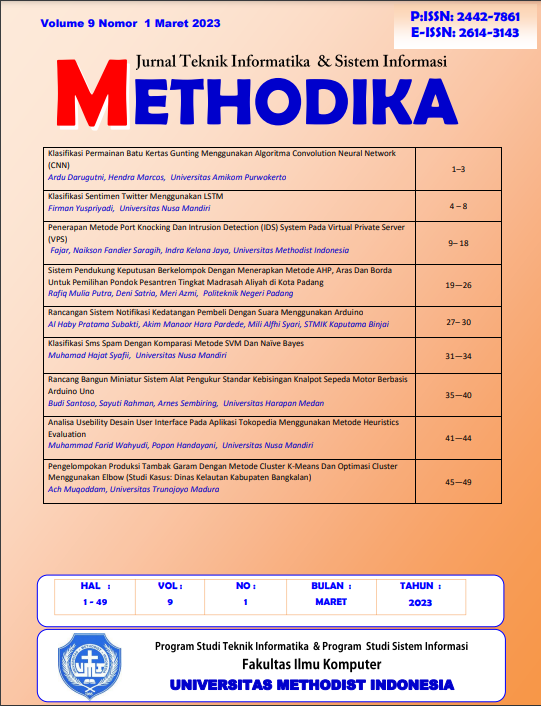PENGELOMPOKAN PRODUKSI TAMBAK GARAM DENGAN METODE CLUSTER K-MEANS DAN OPTIMASI CLUSTER MENGGUNAKAN ELBOW (STUDI KASUS: DINAS KELAUTAN KABUPATEN BANGKALAN)
Keywords:
tambak garam, Algoritma K-Means, Clustering, Data Mining, Optimasi ElbowAbstract
Salt ponds in Madura are known by the Indonesian people as salt producers or it can be said that Madura is generally called a salt island, especially salt ponds in Bangkalan Regency in 2014 salt production increased from the previous year. But not long after that in 2020 and 2021 Salt Pond production decreased. The problem that occurs in the field of salt pond business in Kwanyar District, Bangkalan Regency is to analyze the problems that exist in salt ponds regarding the characteristics and potential of the salt pond business and the salt pond production system. And the problems that exist in the Maritime Service of Bangkalan Regency are difficult to classify salt pond production data. Responding to the problem of salt ponds in Bangkalan, a data mining system is needed to classify salt pond production. The grouping of salt ponds is grouped into 3 clusters. Where 3 groups (clusters) are used here, namely the need to increase production (cluster 1), it is enough to increase production (cluster 2), there is no need to increase production (cluster 3), which is useful for evaluating and providing solutions. The method used is the K-Means Clustering method, as well as finding an optimal group using Elbow Optimization. The results of the K-Means process of grouping the results obtained are group 1 = 65 data that need to increase production, group 2 = 55 data that simply needs to increase production, and group 3 = 21 data that doesn't need to increase production. Elbow Optimization Test to find the most optimal K, by conducting a 7 cluster trial. The result is K = 3 which is optimal from a comparison test with other Ks, looking at the resulting SSE and Elbow Garp values.
References
A. Kadir, “Pengenalan Sistem Informasi,” Am. Enterp. Inst. Public Policy Res., no. August, pp. 1–19, 2014.
Bin Ladjamudin, “Analisis dan Desain Sistem Informasi,” Anal. dan Desain Sist. Inf., vol. 53, no. 9, pp. 1689–1699, 2013.
C. Strapparava and R. Mihalcea, “Learning to identify emotions in text,” Proc. 2008 ACM Symp. Appl. Comput. - SAC ’08, p.1556, 2008.
C. Strapparava and R. Mihalcea, “Semeval-2007 task 14: Affective text,” Proc. of SemEval-2007, no. June, pp. 70–74, 2007.
U. Krcadinac, P. Pasquier, J. Jovanovic, and V.Devedzic, “Synesketch: An Open Source Library for Sentence-Based Emotion Recognition,” IEEE Trans. Affect. Comput., vol. 4, no. 3, pp. 312–325, 2013.
M. A. Suryadi, Kadarsah; Ramdhani, SistemPendukung Keputusan. Remaja Rosdakarya, Bandung, 1998
Downloads
Published
How to Cite
Issue
Section
License
Copyright (c) 2023 ACH. MUQODDAM Adam

This work is licensed under a Creative Commons Attribution 4.0 International License.











